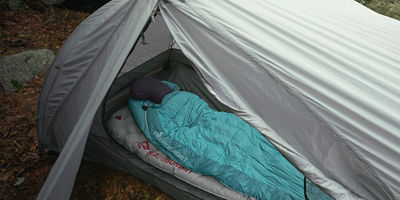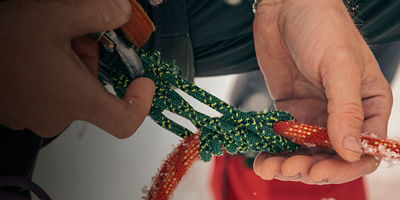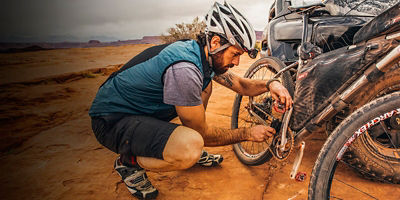How to care for your down gear at home
If you ever feel like your down gear is less warm or less fluffy than it once was, it’s probably just because it’s dirty or compressed, i.e., the loft is compromised. Here’s how to prevent that from happening—and fix it if it’s too late.
Let it breathe
The most obvious—and potentially most important—thing you can do for your down products is to let that loft breathe. Keeping your bags or jackets in their compression sacks for extended periods of time can damage the down. Compress it for several weeks, and it will start taking longer to fully loft. After months in the compression sack, it could lose its ability to loft much at all. That translates to a reduction in warmth.
When not in use, down jackets should be hung up and given room to breathe (not jammed into the closet with a dozen other coats), and sleeping bags should be kept on a wide shelf in the roomy storage sacks they usually come with. Scrunching your sleeping bag into a compression sack a few days ahead of your next trip isn’t going to hurt it, but keeping it in one for months at a time could result in lasting damage.
Store it properly
Over time, humidity can cause down to wilt or molder, and heat can sometimes damage the synthetic fabrics that surround the insulation. Store your down items in places that aren’t excessively hot or humid. A temperature-controlled storage closet, for example, might be better than an uninsulated basement or attic. (A garage can work fine if it’s dry and cool year-round.) Likewise, never put away a sleeping bag when it’s still wet. Make sure your down items are bone-dry before storing them.
Scrub-a-dub-dub
Down products, obviously, aren’t like your gym shorts: You don’t need to wash them after every trip. But over time, they can absorb body oils, sunscreen and sweat, which can both give them a nice funk, and make it harder for the feathers to loft up. This is why after a few seasons your jackets and sleeping bags might not feel as puffy as they once did. Soiled fabrics can also degrade them over time, making it more likely that you’ll tear them or have down fibers leak out in other ways. If you’ve sweated excessively in your sleeping bag or gone on a particularly damp or dirty trip, it’s time for a wash.
Always follow the directions given by the manufacturer of your product—they know it best. But generally, the process should look like this:
- Before you wash, spot-clean individual stains on the face or liner fabrics with light, non-detergent soap and a soft-bristled toothbrush. If you’re only tackling a superficial spill or stain, this step may be all you need.
Find a front-loading washer. Top-loaders have agitators in the center which can damage delicate fabrics. If you don’t have a front-loader at home, head to a laundromat.
Wash your down product with warm water on a gentle cycle with a mild detergent. Even better, use a down-specific wash. Rinse until all the soap is removed. This may take a second rinse, especially if you’re washing a sleeping bag.
Wet down is extremely heavy, and most of these products are made with extremely light materials, which can strain against that weight. Before you try to remove your down product from the washer, run the spin cycle an extra time to remove as much water as possible, and lightly squeeze the product while it’s still in the washer to get rid of more water. Be careful not to wring it out—that could easily tear the face fabric. When you lift your down item out of the washer, scoop it up from the bottom rather than grabbing handfuls of fabric or lifting from the top.
Air dry your down item for a few hours to let the rest of the water to drip out. Then, tumble dry with no heat. This could take several hours, so be patient. Later on, consider tossing in a couple tennis balls or balled-up socks. These will bounce around, ideally releasing clumps of down that might be stuck together. However, they can only do so much. You may also need to gently work down clumps out by hand between dry cycles to get them to fully release.
How to care for your down gear in the field
As they say, an ounce of prevention is worth a pound of cure. Taking care of your down gear when you’re actually in the backcountry or at camp will help it last longer between washes and resist lasting damage.
Avoid sharps and snags.
Many down jackets and sleeping bags are designed to be lightweight, which means they’re more delicate than hard-wearing gear like a tent or a pair of boots. Before you pack a sleeping bag in a car or backpack, use a compression sack to protect it. If you’re going on a rainy backcountry trip, consider storing it in a small drybag or wrapping it in a plastic garbage sack to keep it dry. Avoid packing cookware or other sharp objects near your sleeping bag or puffer, and don’t let it sit on the ground or anywhere it could get scratched or snagged.
Watch the zippers.
Zippers are often the first point of failure for many types of gear. Never force a stuck zipper; you could break the slider or bend the zipper teeth. Also proceed with caution if the fabric gets caught in the zipper slider, as yanking could result in a tear. Instead, pull the fabric gently, straight outward and perpendicular to the zipper slider.
Keep yourself clean.
If you’re dirty, sweaty, or covered in bug repellant when you get into your sleeping bag or put on your jacket, your gear is likely to get dirty, too. Always sleep in base layers and/or consider using a sleeping bag liner to keep your sleeping bag clean. On long trips, try to air out your sleeping bag daily by draping it carefully over a rock or the top of your tent while you make breakfast.
Come prepared.
Sometimes tears and snags are unavoidable. Always head off the grid prepared with a basic repair kit. Gear tape works wonders for quick field patches, and bringing extra zipper sliders and/or zipper lubricant is recommended for longer trips.
























































































































































































































